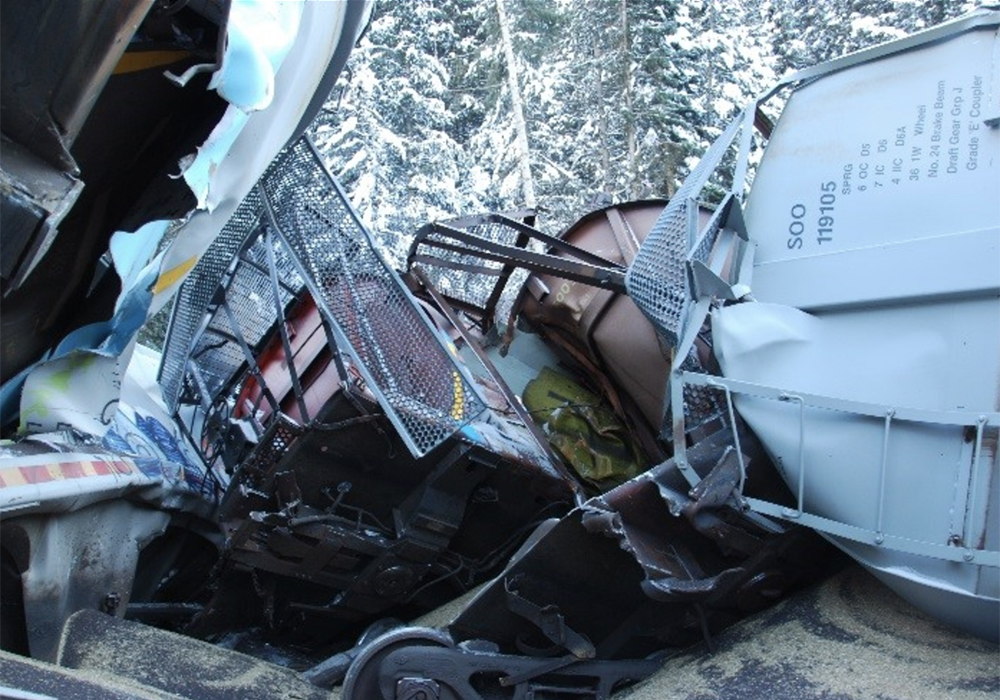The Transportation Safety Board of Canada has issued three recommendations to Transport Canada, aimed at improving the safety of cold weather train operations in the Canadian Rockies and other mountainous regions of Canada.
The recommendations stem from a TSB investigation into a fatal freight train derailment that killed three people in February 2019 near Field, B.C.
They include:
Read Also

Canadian Food Inspection Agency extends chronic wasting disease control program consultation deadline
Date extended for consultation period of changes to CWD program
• A call for enhanced testing standards and time-based maintenance for air-brake cylinders on all freight cars, including grain hopper cars, that operate on steep descending grades in cold ambient temperatures.
• A recommendation that automatic parking brakes be installed on freight cars, especially cars that make up bulk commodity unit trains that operate through mountainous territory.
• A recommendation that Canadian Pacific Railway demonstrate to Transport Canada that it can effectively identify hazards and assess and mitigate risk using all available information.
The recommendations were outlined during a TSB news conference, held March 31 in Calgary, approximately three years after a 112-car grain train derailed on CP’s mountainous Laggan subdivision near Field, killing all three members of the train crew aboard.
CP train 301-349 left Calgary Feb. 3, 2019, bound for Vancouver.
The air brakes on the train were functioning normally when the train left Calgary, but as the unit train progressed through the mountains, it encountered extremely cold temperatures and braking problems.
The train came to an emergency stop at Partridge, B.C., and a new train crew boarded the train, replacing the previous crew that was nearing the end of its shift.
The new crew members, including a locomotive engineer, a conductor and a conductor trainee, were preparing to pilot the train down a nine-mile stretch of track, but before they could begin a controlled descent, the train began to move on its own.
According to the TSB investigation, steps taken by the outgoing train crew to recharge the train’s air brake system had failed.
When the incoming relief crew boarded the train shortly after midnight on Feb. 4, the temperature at Partridge had dropped to -28 C and the train’s brake system had been leaking compressed air, reducing its ability to hold the train in position.
TSB officials said the runaway train reached a maximum speed of approximately 53 m.p.h. on a stretch of steep mountain track that’s rated for a maximum speed of 15 m.p.h.
Hand brakes were not applied to any of the cars following the emergency stop at Partridge, a move that might have prevented the uncontrolled movement and derailment.
“With the benefit of hindsight, had hand brakes been applied, that would have secured the train,” TSB chair Kathy Fox told reporters.
“But you also have to look at all of the circumstances. We can’t change the past. We can’t undo what’s happened. But what we can do is make recommendations so that these sorts of things don’t happen again.…
“That’s why we’re making the recommendation about automatic parking brakes because it is a physical defence (against uncontrolled train movements in the event of and air brake failure).”
Fox said concerns over the uncontrolled movement of rail cars are not new in Canada.
“Unplanned and uncontrolled movement of railway rolling stock have been a concern to the TSB for some time now,” she said.
“In fact, there were 589 such events from 2010 to 2019 (that were) reported to the TSB. And our Lac Megantic investigation clearly illustrated that these are high-risk events that can have catastrophic consequences.
“The TSB remains concerned that the current defences are not sufficient to reduce the number of uncontrolled movements and improve safety.” Fox said new technologies for enhancing train brake performance are available but have not been widely adopted.
Automatic parking brakes, for example, mechanically lock the wheel brakes on freight cars in the applied position when pressure in air-brake systems becomes depleted.
Automatic parking brakes are not affected by cylinder brake leakage, so they can hold a stationery train in position, even in extremely cold ambient temperatures, which contribute to air brake system failures.
“Until physical defences such as automatic parking brakes are implemented across the Canadian railway network, the risk of uncontrolled movements due to inadequate train securement will persist, especially on steep grades where the effectiveness of hand brakes cannot be tested,” Fox said.
TSB officials also acknowledged that while Transport Canada and CP took actions to mitigate risk in the wake of the Field derailment, more needs to be done.
Transport Canada will now have 90 days to consider the TSB’s recommendations and decide if, how and when the recommendations should be implemented.
“Once we assess that (the minister’s) response, we will assess it to see if it addresses the underlying safety deficiencies … and we will continue to follow-up until these recommendations are fully implemented.”
Contact brian.cross@producer.com
















